seats CHEVROLET ASTRO CARGO VAN 2001 2.G Owners Manual
[x] Cancel search | Manufacturer: CHEVROLET, Model Year: 2001, Model line: ASTRO CARGO VAN, Model: CHEVROLET ASTRO CARGO VAN 2001 2.GPages: 388, PDF Size: 2.74 MB
Page 4 of 388
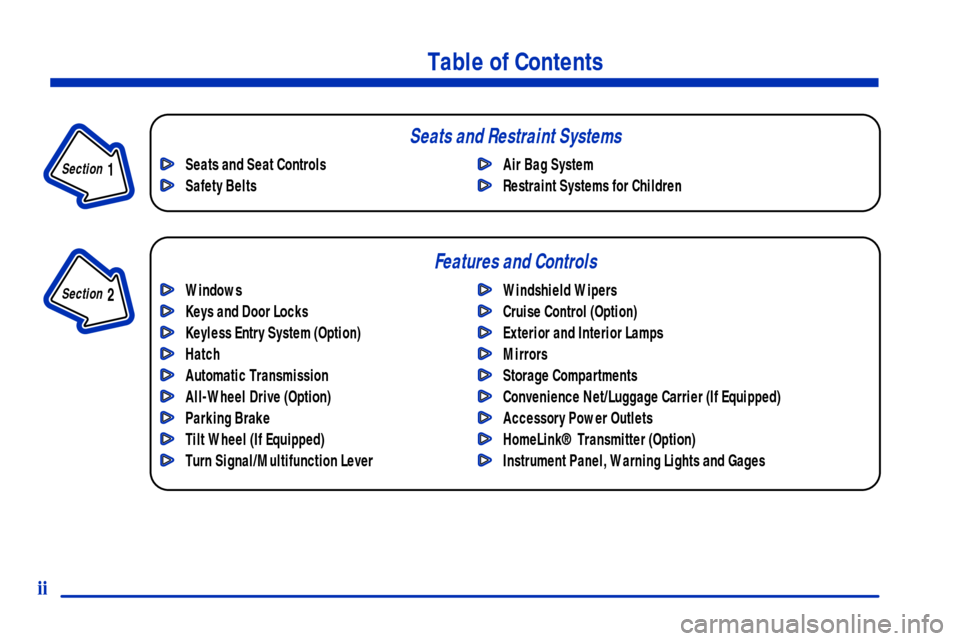
ii
Table of Contents
Windows
Keys and Door Locks
Keyless Entry System (Option)
Hatch
Automatic Transmission
All-Wheel Drive (Option)
Parking Brake
Tilt Wheel (If Equipped)
Turn Signal/Multifunction LeverWindshield Wipers
Cruise Control (Option)
Exterior and Interior Lamps
Mirrors
Storage Compartments
Convenience Net/Luggage Carrier (If Equipped)
Accessory Power Outlets
HomeLink® Transmitter (Option)
Instrument Panel, Warning Lights and Gages Seats and Seat Controls
Safety BeltsAir Bag System
Restraint Systems for Children
Section
1
Section
2
Seats and Restraint Systems
Features and Controls
Page 14 of 388

1-
1-1
Section 1 Seats and Restraint Systems
Here you'll find information about the seats in your vehicle and how to use your safety belts properly. You can also
learn about some things you should not do with air bags and safety belts.
1
-2 Seats and Seat Controls
1
-13 Safety Belts: They're for Everyone
1
-17 Here Are Questions Many People Ask About
Safety Belts
-- and the Answers
1
-18 How to Wear Safety Belts Properly
1
-18 Driver Position
1
-26 Safety Belt Use During Pregnancy
1
-27 Right Front Passenger Position
1
-27 Air Bag System
1
-34 Rear Seat Passengers1
-38 Rear Safety Belt Comfort Guides for
Children and Small Adults
1
-40 Center Passenger Position (Bench Seat)
1
-42 Children
1
-48 Restraint Systems for Children
1
-62 Older Children
1
-65 Safety Belt Extender
1
-65 Checking Your Restraint Systems
1
-66 Replacing Restraint System Parts
After a Crash
Page 15 of 388
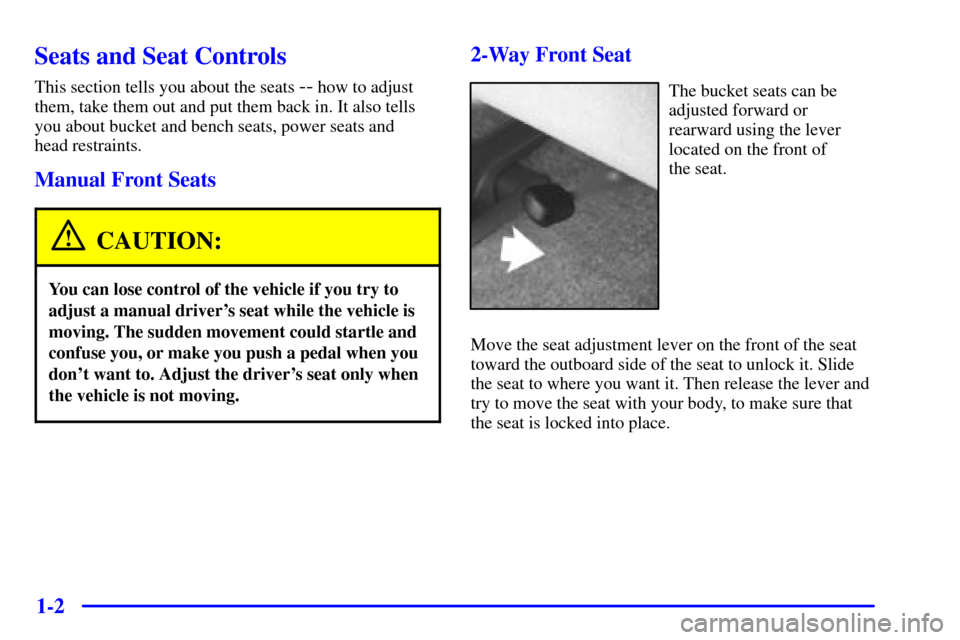
1-2
Seats and Seat Controls
This section tells you about the seats -- how to adjust
them, take them out and put them back in. It also tells
you about bucket and bench seats, power seats and
head restraints.
Manual Front Seats
CAUTION:
You can lose control of the vehicle if you try to
adjust a manual driver's seat while the vehicle is
moving. The sudden movement could startle and
confuse you, or make you push a pedal when you
don't want to. Adjust the driver's seat only when
the vehicle is not moving.
2-Way Front Seat
The bucket seats can be
adjusted forward or
rearward using the lever
located on the front of
the seat.
Move the seat adjustment lever on the front of the seat
toward the outboard side of the seat to unlock it. Slide
the seat to where you want it. Then release the lever and
try to move the seat with your body, to make sure that
the seat is locked into place.
Page 16 of 388

1-3 Manual Lumbar Support (If Equipped)
If you have this feature, there will be a knob located
on the inboard side of the driver's and passenger's
bucket seats.
Turn the knob toward the front of the vehicle to increase
lumbar support. Turn the knob toward the rear of the
vehicle to decrease lumbar support.
Power Seat (If Equipped)
If you have this feature, there will be a control pad
located on the inboard side of the driver's seat.
To raise or lower the front of the seat, raise or lower the
lever located toward the front of the vehicle.
To raise or lower the rear of the seat, raise or lower the
lever located toward the rear of the vehicle.
To move the entire seat backwards, forward, or up or
down, move the center knob.
Page 20 of 388

1-7 Rear Seats
Bucket Seats (If Equipped)
You may have rear bucket seats with an adjustment
release bar located at the front of the seats. These seats
can be adjusted forward or rearward with the release bar.
Pull the release bar up to release the seat bottom and
slide the seat where you want it. Then let go of the
release bar and try to move the seat with your body, to
make sure the seat is locked into place.Bench Seats
Each bench seat can carry up to three passengers.
They can also be removed to increase storage space.
The center bench and rear bench seats can be adjusted
forward or rearward using the lever at the front of
the seat.
Move the seat adjustment
lever located at the front
of the seat toward the
passenger's side to unlock
it. Slide the seat to where
you want it. Then release
the lever and try to move
the seat with your body, to
make sure the seat is locked
into place.
The center bench seat has a pivoting right armrest.
The optional bench seats come with moveable armrests,
individual reclining seatbacks, adjustable headrests and
a fold
-down center armrest console.
Page 22 of 388
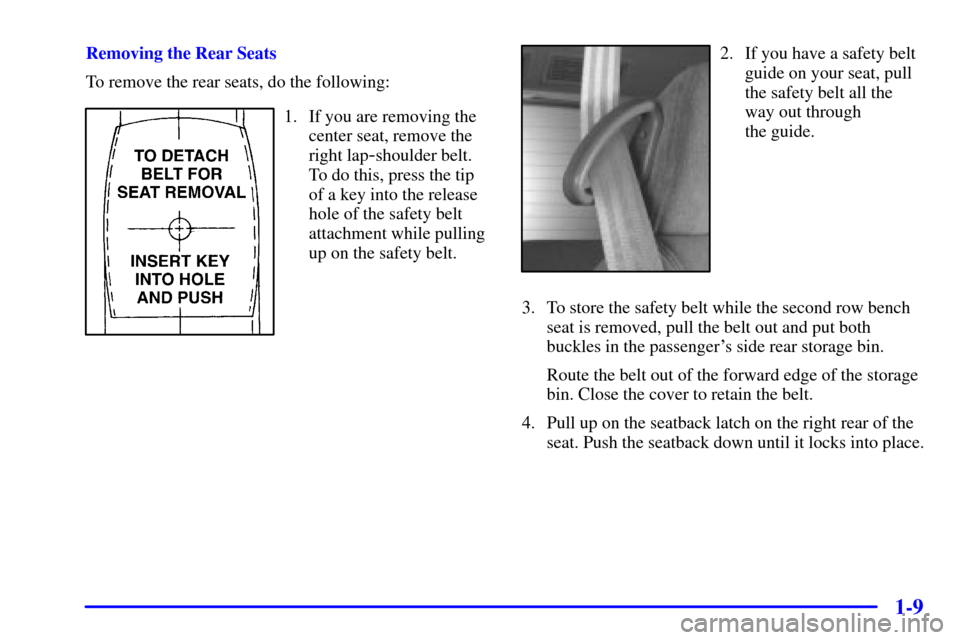
1-9
Removing the Rear Seats
To remove the rear seats, do the following:
1. If you are removing the
center seat, remove the
right lap
-shoulder belt.
To do this, press the tip
of a key into the release
hole of the safety belt
attachment while pulling
up on the safety belt.
2. If you have a safety belt
guide on your seat, pull
the safety belt all the
way out through
the guide.
3. To store the safety belt while the second row bench
seat is removed, pull the belt out and put both
buckles in the passenger's side rear storage bin.
Route the belt out of the forward edge of the storage
bin. Close the cover to retain the belt.
4. Pull up on the seatback latch on the right rear of the
seat. Push the seatback down until it locks into place.
Page 24 of 388

1-11
Replacing the Rear Seats
1. Lower the seat into position. Make sure the front
retainers are hooked onto the anchor pins.
2. Pull the seat down to latch the rear retainers. Make
sure the seat is locked in by pulling up and down on
the seat.
CAUTION:
A seat that isn't locked into place properly can
move around in a collision or sudden stop. People
in the vehicle could be injured. Be sure to lock
the seat into place properly when installing it.
Page 26 of 388
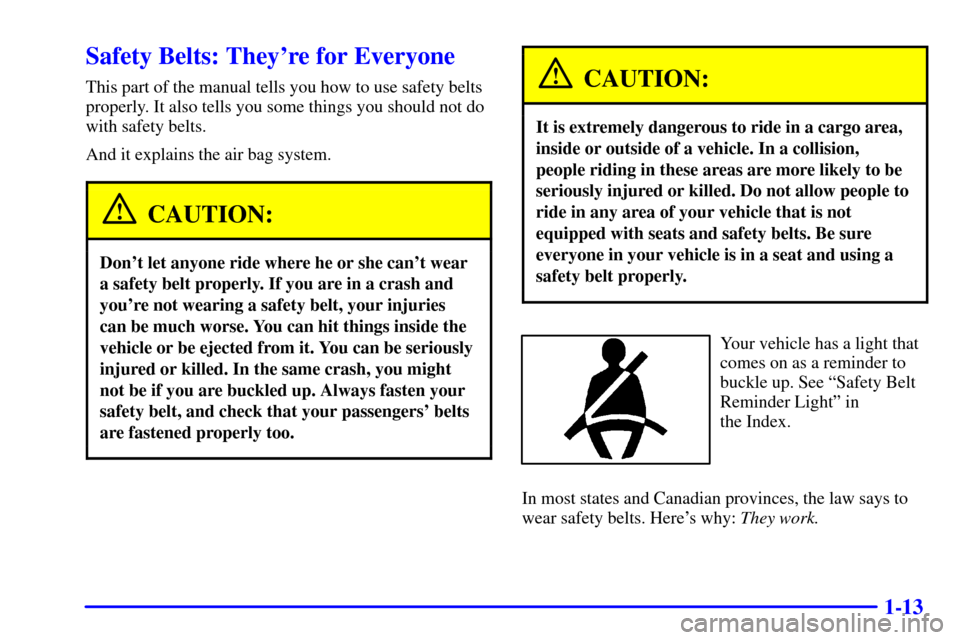
1-13
Safety Belts: They're for Everyone
This part of the manual tells you how to use safety belts
properly. It also tells you some things you should not do
with safety belts.
And it explains the air bag system.
CAUTION:
Don't let anyone ride where he or she can't wear
a safety belt properly. If you are in a crash and
you're not wearing a safety belt, your injuries
can be much worse. You can hit things inside the
vehicle or be ejected from it. You can be seriously
injured or killed. In the same crash, you might
not be if you are buckled up. Always fasten your
safety belt, and check that your passengers' belts
are fastened properly too.
CAUTION:
It is extremely dangerous to ride in a cargo area,
inside or outside of a vehicle. In a collision,
people riding in these areas are more likely to be
seriously injured or killed. Do not allow people to
ride in any area of your vehicle that is not
equipped with seats and safety belts. Be sure
everyone in your vehicle is in a seat and using a
safety belt properly.
Your vehicle has a light that
comes on as a reminder to
buckle up. See ªSafety Belt
Reminder Lightº in
the Index.
In most states and Canadian provinces, the law says to
wear safety belts. Here's why: They work.
Page 31 of 388
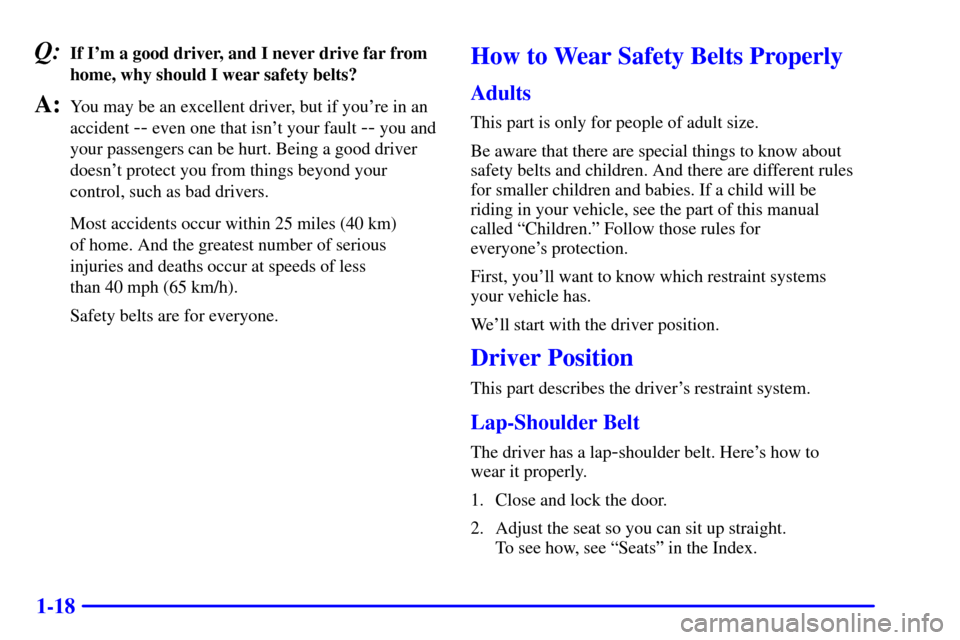
1-18
Q:If I'm a good driver, and I never drive far from
home, why should I wear safety belts?
A:You may be an excellent driver, but if you're in an
accident
-- even one that isn't your fault -- you and
your passengers can be hurt. Being a good driver
doesn't protect you from things beyond your
control, such as bad drivers.
Most accidents occur within 25 miles (40 km)
of home. And the greatest number of serious
injuries and deaths occur at speeds of less
than 40 mph (65 km/h).
Safety belts are for everyone.
How to Wear Safety Belts Properly
Adults
This part is only for people of adult size.
Be aware that there are special things to know about
safety belts and children. And there are different rules
for smaller children and babies. If a child will be
riding in your vehicle, see the part of this manual
called ªChildren.º Follow those rules for
everyone's protection.
First, you'll want to know which restraint systems
your vehicle has.
We'll start with the driver position.
Driver Position
This part describes the driver's restraint system.
Lap-Shoulder Belt
The driver has a lap-shoulder belt. Here's how to
wear it properly.
1. Close and lock the door.
2. Adjust the seat so you can sit up straight.
To see how, see ªSeatsº in the Index.
Page 51 of 388
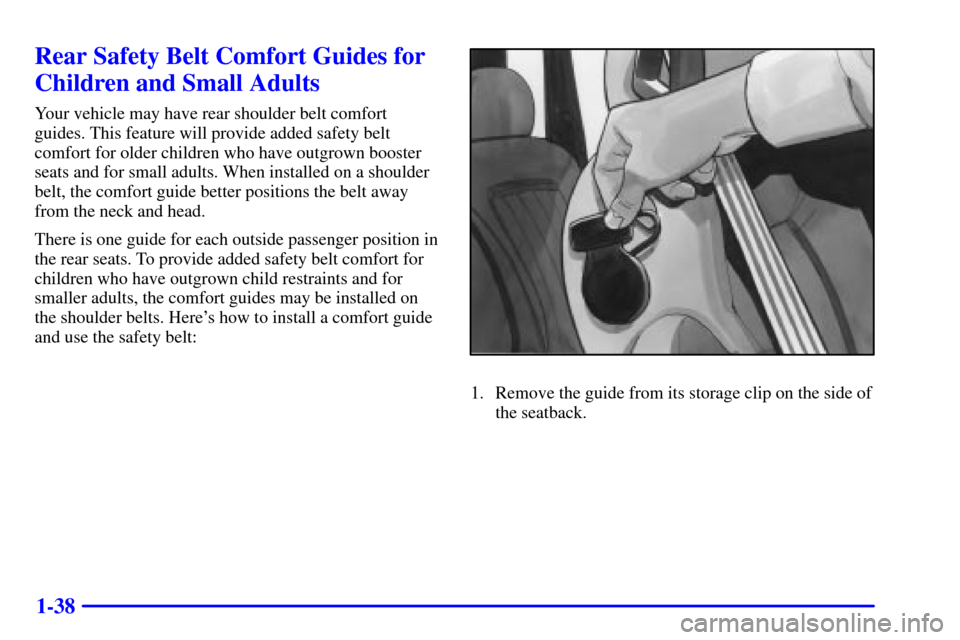
1-38
Rear Safety Belt Comfort Guides for
Children and Small Adults
Your vehicle may have rear shoulder belt comfort
guides. This feature will provide added safety belt
comfort for older children who have outgrown booster
seats and for small adults. When installed on a shoulder
belt, the comfort guide better positions the belt away
from the neck and head.
There is one guide for each outside passenger position in
the rear seats. To provide added safety belt comfort for
children who have outgrown child restraints and for
smaller adults, the comfort guides may be installed on
the shoulder belts. Here's how to install a comfort guide
and use the safety belt:
1. Remove the guide from its storage clip on the side of
the seatback.